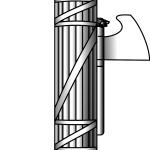8.1: Fascism: “The Answer” to All the Questioning
We have seen at the end of Chapter 7 that, after World War I, there was a lot of bitterness, crushed dreams, despair, and disillusionment. The questions that folks were asking—particularly those two Jewish thinkers we once read about (Einstein and Freud)—caused some to seek out answers which offered firm faith in something (anything) rather than the existentialist alternative of plodding through an ultimately meaningless existence. Especially after this type of depression was compounded with the Great Depression, citizens in three specific countries thought that nationalism, militarism, and imperialism (the causes of WWI) represented the best way out of the darkness.
Fascism is as extremely nationalistic as Communism is extremely internationalistic. Fascism represented a return to the faith, pride, and vision of the Enlightenment for its followers. Without the modern media of film, radio, and newspapers, fascism would probably not exist: it relied on propaganda to give its citizens a distorted view of “the truth.”
Fascism began in Italy, as the name suggests: the “fasce” was the symbol of the Roman Empire’s power and the emperor’s forceful “social contract” with his citizens. The same year that the Treaty of Versailles was signed—1919—the first Fascist Party was formed in Italy. A journalist named Benito Mussolini rose to the ranks of the party with his powerful speaking voice and presence. (Because of his short stature, Mussolini would often stand in balconies to address his audiences.) Mussolini urged Italians not to settle for second-best with the Treaty, but rather to expand into Africa to re-claim the former Roman territories and embrace the “destiny” of the ancient Roman people. In effect, the Italian fascists sought to create a new Roman Empire with a new emperor. Instead of “weak” ideas of cooperation and collaboration (like the Communist dream), fascists had a different vision: absolute obedience to the leader, “Il Duce” in Italian. There should be no political parties, and every individual should serve the state, which is Il Duce. This one-leader, one-party system gained popularity as the ‘20s began. Fascism would only increase in popularity after democracy “failed” to prevent the Depression and keep stability in Europe in the ‘30s.
In 1922, Mussolini (Napoleon-style) took control of Italy from the Italian monarch. Rallying behind Il Duce, the majority of Italian people embraced this vision of confidence, strength, and nationalistic unity. Inspired by the fascist take-over, Germans in Munich calling themselves “National Socialists” (Nazis for short) followed suit: In 1923, a small band of German fascists led by World War I veteran Adolph Hitler attempted to take over the regional capital of Munich by force. This was a complete failure, as the fascist party in Germany was much more unpopular than it was in Italy.
Hitler was sentenced to several years in jail but, due to the terrible economic conditions of the country, was released after only one year. The German government probably did Hitler a favor by imprisoning him: he was always a fiery, passionate speaker, but the time in confinement gave him the opportunity to solidify his thoughts in a book. Hitler’s book, Mein Kampf (which means “My Struggle”), was first published upon Hitler’s release in 1924. Hitler took the ideas of Mussolini one step further and made them more “scientific”: applying the ideas of social Darwinism to Europe’s own races, Hitler claimed that there were certain European ethnicities that were more “naturally” superior than others. The German race, descended from the Aryans of the ancient world (a completely incorrect claim), was destined to be the strongest, the most advanced, and the most civilized race on Earth. But, if this was the case, how had the Germans lost the war?
Hitler developed a conspiracy theory to explain this: there were certain “parasite” races that fed off of German strength for financial gain. Among these races were the Slavs (ethnicities like the Russians who, Hitler claimed, developed Communism to take over the world), Afro-Europeans, and, the biggest “parasites” of all, the Jews. Hitler’s anti-Semitism was nothing new: we have already seen on several occasions how very religious Christians throughout the medieval and early modern eras targeted Jews for their religion: their “stubbornness” in not accepting Christ as Savior. However, Hitler took this religious hatred and added a new, fake-“scientific” element: Hitler’s hatred was mostly based on the fact that the Jews were not just a religion, but a race, descended from the ancient Hebrews. Hitler and the Nazis saw the entire past two thousand years as a secret take-over by the Jews of the entire world: operating as a small minority in every country and gaining economic advantage over their “superiors.” Jews like Einstein and Freud questioned the traditional order and asked very dangerous questions to serve the “Jewish plan” to further confuse and undermine the German “master race.” Worst of all for the Nazis, some Jews had already married into “pure Aryan” families and produced (as they saw it) “part-parasite” offspring. In addition, some German males were “wasting” their “pure Aryan” genes by “practicing homosexuality.”
Hitler’s philosophy, therefore, was all about the perversion of history and science to create a new mythology based around the scientific experiments of the Enlightenment. Hitler’s “hypothesis” was that a Germany without the Jews in power would be prosperous once again. However, according to the Nazis, in order to “prove” this theory, only one leader could be in control—Der Fuhrer (German for “The Leader”). According to Hitler, democracy was bound to fail: the Jews had worked their “influence” on weak democratic leaders when Germany signed the Treaty of Versailles and upheld its German-hating agenda.
With Hitler’s propaganda machine, the Nazis gained followers—especially after The Great Depression, which the Nazis spun as the victory of the “Jewish-Communist conspiracy.” Hitler’s powerful presence, using minority scapegoats in addition fake-scientific “reasoning,” soon convinced nearly a third of the country that Nazism/fascism was the only solution to Germany’s increasing problems. However, Hitler would still have most likely had a more difficult time solidifying control after the 1932 election—if the German government building, the Reichstag, had not burned down. We may never know the true cause of that fire, but Hitler and the Nazis were quick to blame their scapegoats and, after Hitler was sworn in as Germany’s Chancellor in 1933, he gained total control of the government.
Similar developments occurred in the Far East, as Japan (like Italy, an Allied Power unsatisfied with its territorial gains in the Treaty) moved towards a more militaristic, fascist-like government, requiring absolute obedience to the Emperor. With their early start in industrialization, the Japanese took great pride in the nation’s accomplishments. The Emperor and his military advisers soon devised a plan to increase the Japanese economy through a new wave of Pacific Ocean imperialism: “The Greater East Asia Co-Prosperity Sphere” would unite Asian countries under the “best” leader (Japan’s emperor), working to remove European influence and become a true Pacific Empire.
Realizing that all three countries shared very similar ambitions and goals, these three “Axis Powers” were soon united: Hitler’s dream was to conquer Europe, the Japan’s empire was to conquer Asia, and Italy wanted to restore the Roman Empire in the southern Mediterranean and throughout Africa. Though this “global take-over” does look like the plot-line of a comic book, this was very nearly reality, particularly as the Depression limited democratic countries’ powers. Axis nations, on the other hand, like their Communist enemy the U.S.S.R., were outproducing the rest of the world because they were working on a buildup of their militaries (forbidden by the Treaty, in Germany’s case). It’s a sad fact that industrialized war improves the economy, as the “products” are meant to be destroyed very quickly. While the individual was subservient to the state in this pre-war effort, the Axis states prospered. Soon enough, the states were on the move, “unifying” master-races and attempting to put the “weaker” races in their (conquered) places.
Indeed, throughout the 1930s, the Axis was on the move: in 1931, Japan invaded Manchuria (an area of China); in 1936, Italy invaded Ethiopia (the only African nation to escape the first wave of imperialism); and, in 1935-1938, Hitler expanded into other German-speaking “Aryan” areas of Europe (Austria and, later, parts of Czechoslovakia). In some cases, the inhabitants greeted the Nazis with cheers, desiring to be united with other members of the “master race.” Britain drafted an agreement in 1938 to stop German expansion, which Hitler signed (and later broke).
While the inter-war period continued, two alarming developments simultaneously occurred: Hitler got his “house in order” with the beginnings of what would become The Holocaust, and the League of Nations, supposed to prevent another world war, did… little to stop it.

